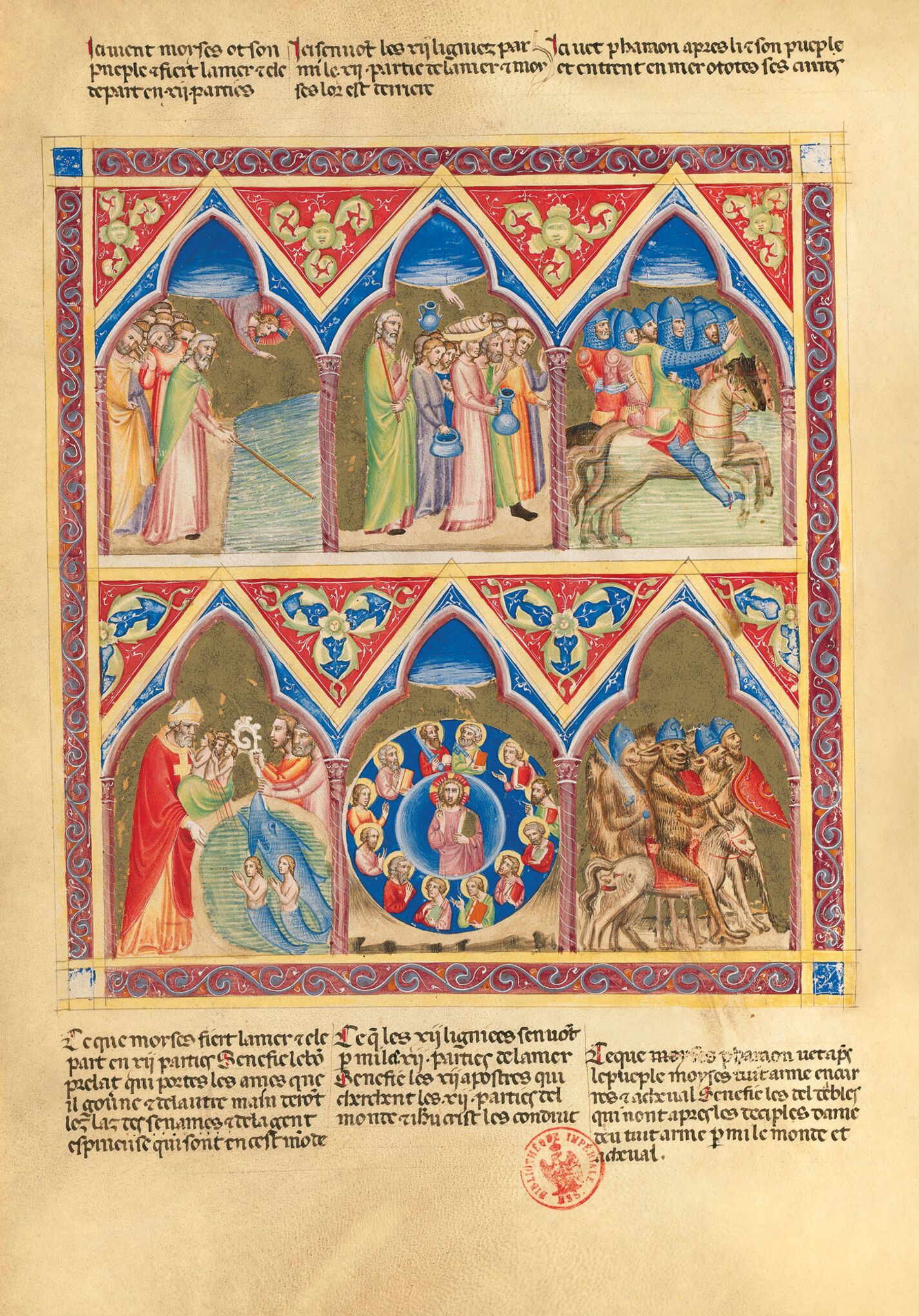“Here comes Moses with his people and he strikes the sea and it divides into twelve parts. Here go the twelve tribes along the twelve parts of the sea and Moses goes behind them. Here we see Pharaoh and his people behind and they enter the sea with all their chariots.”
Folios 62v-63r once again use a panoramic synopsis for the long, six-panel sequence of the crossing of the Red Sea. Moses strikes the sea with his rod and creates twelve paths through the waters which the Hebrews walk along with dry feet. Pharaoh’s horsemen sent after them already have water up to the chest of their mounts (f. 62v).
It can be seen at a glance that the twelve paths through the sea are not depicted and that instead of the chariots of the Egyptian army only horsemen in chain mail can be seen. Moses striking the sea and dividing it into twelve parts signifies the good prelate carrying the souls he rules over. The allegorical image is literal: an archbishop in a red chasuble carries three souls in a pistachio green cloth. His gloved, right hand unties the mermaids and the difficult people of this world. The two mermaids described as “senames” are well portrayed and likewise the sperm whale inside the disc of the world behind which two Jews may be seen, one of whom absurdly has a bishop’s crosier. The moralisation image of the Hebrews entering the twelve paths Moses made across the bottom of the sea is, as mentioned before, very abstract and is translated, in the three-volume Bibles, into an image of Christ leading his twelve apostles. The chariots of war overlooked in the Bible of Naples are depicted in the three-volume Bibles in the form of a four-wheeled chariot. In the Bible of Saint Louis it is full of foot soldiers and already half under water like the horsemen in the Bible of Naples. In Naples, Pharaoh’s army signifies an army of devils led by a demon astride a horse with a grotesque human head for its hindquarters.
The Bible of Naples carefully lays out the first four illustrations of the Exodus on four folios: the Jewish people enslaved, the attempt at ethnic cleansing, the birth of Moses and his being released in the river and, finally, Moses rescued from the waters. The next part of the narrative, however, flows less smoothly.
Yves Christe
University of Geneva
Marianne Besseyre
Illuminated Manuscripts Research Center, Bibliothèque nationale de France
Fragment of the Bible moralisée of Naples commentary volume

“Here comes Moses with his people and he strikes the sea and it divides into twelve parts. Here go the twelve tribes along the twelve parts of the sea and Moses goes behind them. Here we see Pharaoh and his people behind and they enter the sea with all their chariots.”
Folios 62v-63r once again use a panoramic synopsis for the long, six-panel sequence of the crossing of the Red Sea. Moses strikes the sea with his rod and creates twelve paths through the waters which the Hebrews walk along with dry feet. Pharaoh’s horsemen sent after them already have water up to the chest of their mounts (f. 62v).
It can be seen at a glance that the twelve paths through the sea are not depicted and that instead of the chariots of the Egyptian army only horsemen in chain mail can be seen. Moses striking the sea and dividing it into twelve parts signifies the good prelate carrying the souls he rules over. The allegorical image is literal: an archbishop in a red chasuble carries three souls in a pistachio green cloth. His gloved, right hand unties the mermaids and the difficult people of this world. The two mermaids described as “senames” are well portrayed and likewise the sperm whale inside the disc of the world behind which two Jews may be seen, one of whom absurdly has a bishop’s crosier. The moralisation image of the Hebrews entering the twelve paths Moses made across the bottom of the sea is, as mentioned before, very abstract and is translated, in the three-volume Bibles, into an image of Christ leading his twelve apostles. The chariots of war overlooked in the Bible of Naples are depicted in the three-volume Bibles in the form of a four-wheeled chariot. In the Bible of Saint Louis it is full of foot soldiers and already half under water like the horsemen in the Bible of Naples. In Naples, Pharaoh’s army signifies an army of devils led by a demon astride a horse with a grotesque human head for its hindquarters.
The Bible of Naples carefully lays out the first four illustrations of the Exodus on four folios: the Jewish people enslaved, the attempt at ethnic cleansing, the birth of Moses and his being released in the river and, finally, Moses rescued from the waters. The next part of the narrative, however, flows less smoothly.
Yves Christe
University of Geneva
Marianne Besseyre
Illuminated Manuscripts Research Center, Bibliothèque nationale de France
Fragment of the Bible moralisée of Naples commentary volume